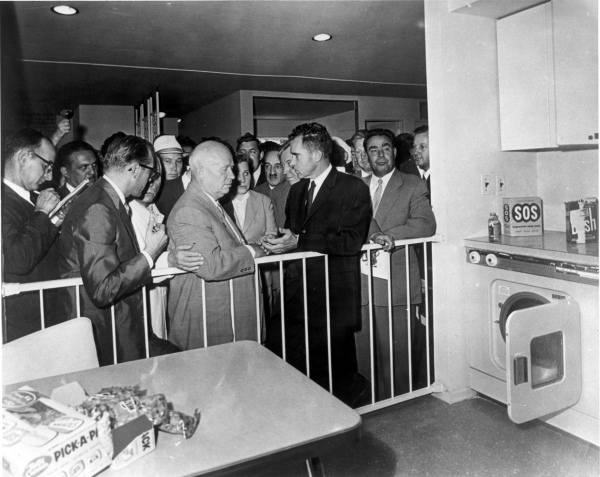A kitchen is not a room. It is a space. A geometric, physical and mental space.
Kitchens have had a main role in the historical definition of the idea of home and family, and subsequently, in the creation of gender biased relationships within the domestic sphere. Nevertheless, technological innovation and new kitchen appliances enabled the emancipation of women.
A kitchen developed from being the centre of the house with the fire heating, to a separate space, from a communal kitchen and shared meals, to the nuclear family eating around the kitchen table. It was skipped for efficiency reasons, it later became highly efficient, standardised, an open hybrid space, to reach the single peoples society and individual eating, while recently we experience its come back as a shared space at co-living models. A kitchen and its continual redesign and reinventing reflect social, economic and political change throughout the world.
60 years ago, a model of a typical American kitchen, showcasing the comforts of the American lifestyle, was the centre of a conflict between Richard Nixon and Nikita Khrushchev, a photograph that became a symbol of tensions between Russia and the U.S. known as the “The Kitchen Debate”. A kitchen is not a room, is a socio-political space.
“A kitchen is not a room” started last December as an experiment in the context of an on going research and on the occasion of a newly established communal kitchen at Akademie Schloss Solitude. For the first time in almost 30 years of the Academy´s existence, the fellows gained access to a communal space. Not a space of working but a space of commons and story- telling, formal and informal interactions. A place where people meet and the every day ritual of eating becomes a social act, sharing and exchanging. Coming from diverse backgrounds and practices, fellows see Solitude as a place for learning and making. Preparing food and eating is one of the most well preserved cultural artefacts no matter which culture. Spaces may vary from climate to climate, ingredients as well but the performatives of the kitchen go beyond food preparation and eating.
»food is a type of language that helps human beings to express their basic perceptions of reality.«
Claude Lévi-Strauss, Le Cru et le cuit, Mythologiques, 1964
On the occasion of this year’s Winterfest with the title “news from nowhere” – (un)known communities”, the communal kitchen opened its doors to the public with an edible installation of architectures and memories. Engaging with personal kitchen stories, the experiment went beyond the mere geometry of the kitchen. After long experimentation and in the established DIY paper making laboratory, all the ingredients and fibres were mixed and edible paper was produced and printed in each contributor ́s memory and flavour.
In our highly digitalised world, the experiment discussed the organic, the analogue and the digital, focusing on the handcraft of paper making, challenging the materiality of paper as a medium for communicating architectures two-dimensionally, allowing it to become three- dimensional, at its own will. The topics of sustainability and food waste, the ephemeral of consumables, colonialism and the exploitation of human and natural resources and how food consumption impacts contemporary culture at large, are core topics to this project. Pineapples, one of the most important and popular foods worldwide, protagonists of colonial and neo-colonial crimes- here specifically pineapple cores that usually land in the trash- offered their fibres as main ingredient.
The outcome of this experimental process was an edible installation open to the broad audience of the festival, offering a multi sensory experience, a space for conversation and collective learning, a place for transmission of knowledge, investigating food, space, and memory. A gastrosophic experiment on sharing, commons and the socio-political dimensions of the kitchen, that tried to connect culture and space, shelter and food, the common denominator to all our practices. The possibility to touch, read, smell, and taste the installation rather than just look, opened up a discussion on the conventional definition of “food culture,” revealing different ways of living together.
In the concept of anthropophagy, movement that developed within Brazilian modernism and suggested the metaphorical devouring of the cultural stranger, Andrade himself writes that anthropophagy is the one that unites all cultures, a law that applies across nations is a concept that has universal validity. This experiment is an invitation to not differentiate oneself from the content but to cannibalise and incorporate the best of it.
With the kind support of Enno Lehmann, head of the workshop for painting techniques @abk-stuttgart
